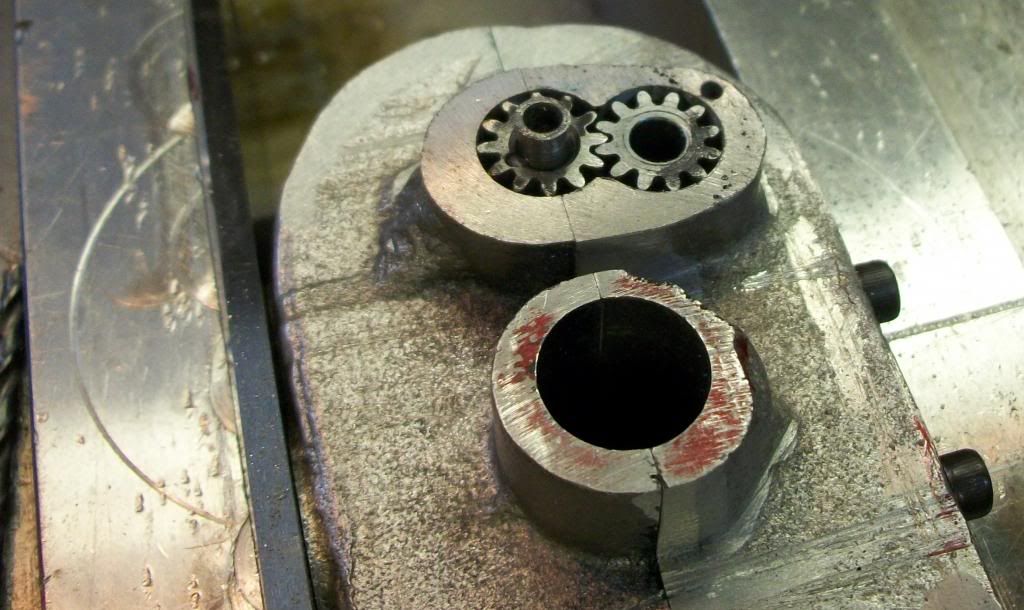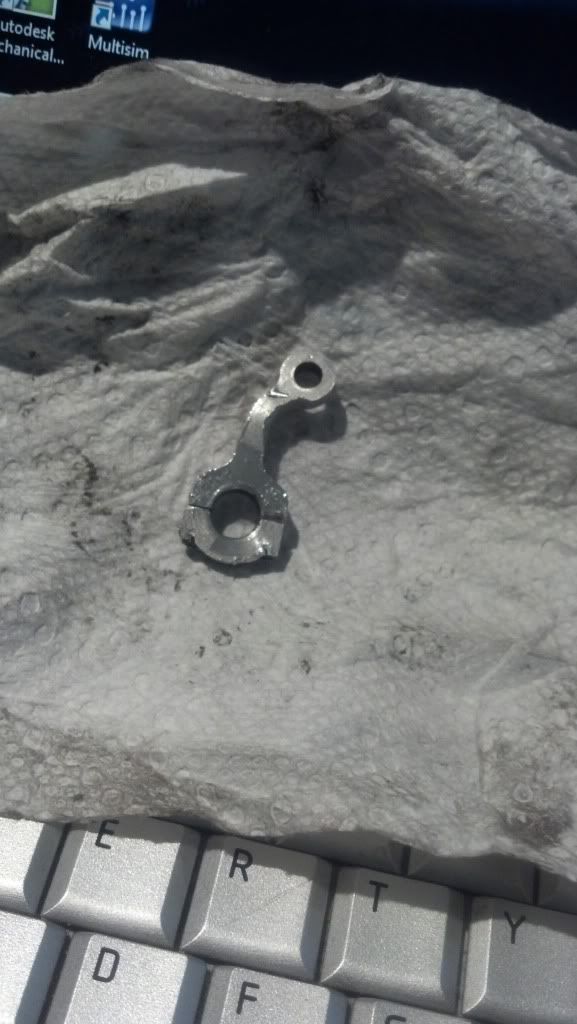You are using an out of date browser. It may not display this or other websites correctly.
You should upgrade or use an alternative browser.
You should upgrade or use an alternative browser.
Jim builds his second v-8
- Thread starter jpeter
- Start date

Help Support Home Model Engine Machinist Forum:
This site may earn a commission from merchant affiliate
links, including eBay, Amazon, and others.
Had a look at your connecting rods.
Maybe you should look at making connecting rods with a dipper as per the photo of a Kohler Industrial Engine Rod
These are splash lubricated and the dipper flings the oil up into the upper crankcase
Some dippers are drilled to direct oil onto the big end bearing

Maybe you should look at making connecting rods with a dipper as per the photo of a Kohler Industrial Engine Rod
These are splash lubricated and the dipper flings the oil up into the upper crankcase
Some dippers are drilled to direct oil onto the big end bearing

Nah, I went down to 9/32 from what was 5/16. Some earlier quote I said I was grinding 0.005 per pass. What I should have said was I reduced the diameter 0.005 per pass. I took lots of passes, more on some journals than others. Took the mains down from 7/16 to 13/32. The bushing in the rear main has flanges for thrust. The front main is a straight bushing and the 3 center ones are split. Got those 3 yet to do.Jim,
That sure looks better than the last photo of the crankshaft I saw, seems to me if .005 was all you had to reduce the diameter you came out lucky. Good work.
Art
Had a look at your connecting rods.
Maybe you should look at making connecting rods with a dipper as per the photo of a Kohler Industrial Engine Rod
These are splash lubricated and the dipper flings the oil up into the upper crankcase
Some dippers are drilled to direct oil onto the big end bearing
No doubt the dipper works but in my case the oil pan's not deep enough. I've been thinking about remaking the oil pan. Currently it's like an automotive one with a deep reservoir on the rear. I'd like to stick with that design. Still thinking about that.
No doubt everyone knows this but me:
I recently had to drill a 1/8 square hole an inch deep. EDM is such a project for me I hate to set up for it. In an emergency I can burn out taps and such but setting up is such a project. After walking in circles for a day or two a knowledgeable friend said use a wobble broach. I googled one to see what it was, made one from tool steel 3 inches long, hardened it and used it. I offset the lathe tailstock 0.050 to create the wobble. Took a minute or so to square out a previously drilled pilot hole. Try it sometime. Interested? I'll gladly supply more details.
Last edited:
I'm wanting to make an oil pump. Gonna drive it off a gear off the cam, same gear from which I drive the distributor. Thought a gear pump would be the way to go but after looking at some designs it seems auto motors use what's commonly called a gerotor pump. Anybody ever make one of those? Can they be made accurately enough by a Sunday machinist to actually work? Just wondering.
I'm wanting to make an oil pump. Gonna drive it off a gear off the cam, same gear from which I drive the distributor. Thought a gear pump would be the way to go but after looking at some designs it seems auto motors use what's commonly called a gerotor pump. Anybody ever make one of those? Can they be made accurately enough by a Sunday machinist to actually work? Just wondering.
Just build a gear pump jimbo! Auto makers used them for years and they work well. Even high volume performance pumps are gear pumps.

$39.99
$49.99
Sunnytech Low Temperature Stirling Engine Motor Steam Heat Education Model Toy Kit For mechanical skills (LT001)
stirlingtechonline

$45.99
Sunnytech Mini Hot Air Stirling Engine Motor Model Educational Toy Kits Electricity HA001
stirlingtechonline

$18.90
$22.90
Woodturning Double Ended Bowl Calipers Stainless Steel 11Inch Woodworking Caliper Tools
sdltools

$25.34
$34.99
Bowl Sander Tool Kit w/Dual Bearing Head & Hardwood Handle | 42PC Wood Sander Set | 2" Hook & Loop Sanding Disc Sandpaper Assortment | 1/4" Mandrel Bowl Sander for Woodturning | Wood Lathe Tools
Peachtree Woodworking Supply Inc
Lakc
Well-Known Member
I'm wanting to make an oil pump. Gonna drive it off a gear off the cam, same gear from which I drive the distributor. Thought a gear pump would be the way to go but after looking at some designs it seems auto motors use what's commonly called a gerotor pump. Anybody ever make one of those? Can they be made accurately enough by a Sunday machinist to actually work? Just wondering.
Gerotor pumps require internal gearcutting or making a broach. So I guess it depends on which Sunday machinist you are.
Regular spur gears make an effective pump, and would be much easier. Not as much volume to work with, but it will move some oil.

Dont do it like I did unless you have a surface grinder and a way to accurately bore holes to perfect depth's.
In small sizes a gear pump still flows a lot of oil. I wanted to add a sump oil system to an RC four stroke engine and did the math on volume flow, and even with some very small gears the volume was several times what I wanted. i haven't looked closely at gerotor design, but with CNC I think it would be practical to make in the home shop. At the size you're talking about it may not be easy.
I don't remember the engine being designed for pressure oiling. What will you do with the oil, jets?
Greg
I don't remember the engine being designed for pressure oiling. What will you do with the oil, jets?
Greg
I've had tougher projects. I'm still thinking about it. I think I can do it.In small sizes a gear pump still flows a lot of oil. I wanted to add a sump oil system to an RC four stroke engine and did the math on volume flow, and even with some very small gears the volume was several times what I wanted. i haven't looked closely at gerotor design, but with CNC I think it would be practical to make in the home shop. At the size you're talking about it may not be easy.
I don't remember the engine being designed for pressure oiling. What will you do with the oil, jets?
Greg
Lakc
Well-Known Member
Just remember that work dont come for free. All that oil pumping will add drag to the engine.
CNC-Joe
Well-Known Member
AWESOME WORK, Jim !!!
Very innovative machining methods, too!
Sure glad to be part of the same metalworking group as you, so I can drool over your engines (( If I can yank them out of Steve Huck's hands, that is ))
Very innovative machining methods, too!
Sure glad to be part of the same metalworking group as you, so I can drool over your engines (( If I can yank them out of Steve Huck's hands, that is ))
AWESOME WORK, Jim !!!
Very innovative machining methods, too!
Sure glad to be part of the same metalworking group as you, so I can drool over your engines (( If I can yank them out of Steve Huck's hands, that is ))
Thanks, wondered who you were. Now I know.
Gerotor pumps require internal gearcutting or making a broach. So I guess it depends on which Sunday machinist you are.
Regular spur gears make an effective pump, and would be much easier. Not as much volume to work with, but it will move some oil.

Dont do it like I did unless you have a surface grinder and a way to accurately bore holes to perfect depth's.
Great picture. That helps a lot. That's pretty much like what I'm going to do.
Lakc
Well-Known Member
Its pretty simple in principle, and a good exercise in practice, because any excess in clearance, or inaccuracy in pitch circle, and it just plain wont work.Great picture. That helps a lot. That's pretty much like what I'm going to do.
Holy smokes theres no wonder why you couldn't turn it over. It didn't look that bad when I saw it. Guess I should have looked a little closer.
starnovice
Member
- Joined
- Nov 21, 2010
- Messages
- 194
- Reaction score
- 23
Sorry for you loss, Jim. Why does it always have to happen in public???
Lakc
Well-Known Member
That fix should involve far less work then the last one. Like my son in law, running through a puddle (lake!) on outer drive in the torrential rainstorms two weeks ago, you pretty much only bend rods by hydrostatic lock. Too much fuel or a coolant leak?
At least you only have to fix one rod, I get to put a whole engine in a Stratus.
At least you only have to fix one rod, I get to put a whole engine in a Stratus.
Pretty convinced the cap came off. Then when the crank came back around it smacked the rod. Could have broke the cylinder. Glad the flywheel came loose. Got lucky. Not gonna be too hard to fix. Not real happy with the play in all the rods. Might just make all new ones. First time the v8's been open since built 3 years ago. Should have inspected it a time or two.That fix should involve far less work then the last one. Like my son in law, running through a puddle (lake!) on outer drive in the torrential rainstorms two weeks ago, you pretty much only bend rods by hydrostatic lock. Too much fuel or a coolant leak?
At least you only have to fix one rod, I get to put a whole engine in a Stratus.
Well cool weather's here so I got back into the shop for the New Victory. Ground the crank, made new rods, redesigned the cam and recut it. I need to show videos and photos of how that was done. Developed a pretty slick method, for me at least, of cnc'n the cam. Finally got it running. Had lots of trouble with the ignition system but seem to have them solved. Anyway, here's a video of a good run. [ame]http://www.youtube.com/watch?v=67qPi0Yfpxo[/ame]
By noting the dipstick popping up and down I think I need more venting in the crankcase. Maybe what I really need is less blow-by. I liked when the mounting screw pulled out causing it to jump around a little. Don't you think it gave the video some life? Comments appreciated.
By noting the dipstick popping up and down I think I need more venting in the crankcase. Maybe what I really need is less blow-by. I liked when the mounting screw pulled out causing it to jump around a little. Don't you think it gave the video some life? Comments appreciated.
Last edited:
Similar threads
- Replies
- 2
- Views
- 1K




















